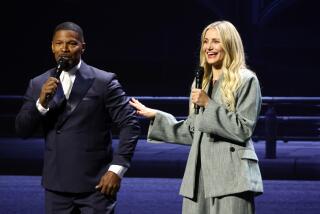Reinventing online ads
- Share via
British television producer Mark Burnett turned program financing on its head a decade ago when he brought brands like Doritos and Mountain Dew as sponsors into the expensive, prime-time reality series “Survivor,” helping to defray costs.
“Survivor” is considered a watershed in paid product placements, opening the floodgates to a projected $2.75 billion in spending this year on such shows as “The Tonight Show With Jay Leno,” WWE’s “Monday Night Raw,” “American Idol” and “Celebrity Apprentice.” Before “Survivor,” brands got promotional placements in exchange for use of a prop, such as a car, or as a bonus for buying commercial time.
Burnett is now trying to bring that formula to the Web through his investment in the Vimby digital production studio. The Van Nuys venture launched in 2005 with a network of filmmakers around the country who create original, short-form videos for Vimby’s website that now also may find a home on other sites including YouTube and Myspace. As part of Burnett’s investment in 2010, Vimby began rubbing elbows with such major advertisers as Aflac, General Mills, Macy’s, McDonald’s, Pepsi and Puma — helping these brands create their own content for distribution on YouTube or on a company’s Facebook page.
“Mark Burnett said, ‘Guys, we need to build an arsenal, a bigger toolbox, working with General Mills, with Pepsi, doing stuff in a way that’s consistent, authentic and involves great story-telling,’” Vimby founder and Chief Executive Dean Waters said of the digital studio’s expanded focus.
Under Burnett’s influence, Vimby’s filmmakers have widened the lens, creating stories not only for the Web but also for TV, as was the case with an MTV special that followed five young women to New York, where they competed to become a Seventeen Magazine cover model. On other occasions, brands pay Vimby to create content that the advertiser can use to build an online community or cultivate greater affinity with its consumers. Macy’s Million Dollar Makeover promotion drew 20,000 applicants from around the country, eight of whom were selected as finalists to participate in a reality-TV-styled competition that attracted 1 million new fans to the retailer’s Facebook page.
Burnett isn’t the first television producer whom brands have sought out to create high-quality, low-cost entertainment for the Web and beyond. Several other veterans from the traditional media world, including former top network executives such as ABC’s Lloyd Braun, NBC’s Ben Silverman and the WB’s Jordan Levin and independent producers like Jak Severson, also are looking to capture audiences as they move to these digital platforms. Big brands are tagging along, in hopes that such proven players can find their footing online.
A significant portion of the U.S. population goes online to check out YouTube videos, update their Facebook status or watch music videos and TV shows through services including Vevo and Hulu. Some 182 million Internet users spent an average of five hours a week on the Web in September and watched nearly 40 billion videos, according to ComScore Inc.
Advertisers predictably are following the viewers online, with spending projected to reach $31.3 billion this year in the U.S. — an increase of 20% over 2010, researcher EMarketer predicts.
As new gadgets and services deliver entertainment to young, digitally savvy viewers, advertisers are scrambling to respond. Initially, brands took a direct marketing approach, focusing on buying search terms to spur sales of particular products. Although search advertising remains the single largest segment of spending on the Web, its growth has slowed as brands look for new ways to connect with consumers.
“Brands are starting to think more about, ‘How do we become the destination?’” said Jason Deal, digital director at the Initiative ad agency. “How do we create advertising that draws consumers to us, instead of solely interrupting people” through banners and search ads?
The breadth of online experimentation is wide, from traditional sponsorships and product placements to “branded content” — in which advertisers use entertainment to communicate with audiences in an original way.
Hyundai, for example, attracted attention to its sporty Veloster subcompact car by sponsoring a mash-up, in which five prominent DJs reinterpreted the traditional musical genres of classical, country, R&B, jazz and rock. The resulting documentary is promoted on Hyundai’s YouTube channel as well as a series of live events.
“The marketing leadership at Hyundai had the mind-set that we have to become the content that consumers are looking for, not just a disruption,” Deal said.
Severson, CEO of Thoughtful Media Group Inc., a digital studio, is seeking to emulate a formula that has succeeded for YouTube celebrities such as stand-up comedian Shay Carl, who has attracted more than 1 million regular followers (self-described ShayTards) and logged more than 14 million views since he began posting videos.
“Their level of effectiveness in driving continual, sustained, religiously devoted audiences — there is nothing in the world like it,” Severson said.
Severson is using actors and professional writers to construct his own YouTube personalities, in hopes of building a sizable enough audience to interest advertisers. One character, Monty, a middle-aged man who lives in his grandmother’s basement, delivers product reviews that comically veer into unrelated topics — such as his infatuation with actress Christina Ricci. So far Monty’s YouTube show, “What’s What,” doesn’t rank among YouTube’s most popular: It has about 7,900 subscribers.
“It doesn’t happen on Day 1,” Severson said.
One of the most enduring forms of advertising — paid product placements — already has taken root on digital platforms. The practice dates back to Charles Dickens, whose novel “The Pickwick Papers” draws its title from the carriage line from the author’s time, according to Patrick Quinn, president of PQ Media, a research firm.
Now a film and television staple, paid product placements are expected to reach $55 million online this year, Quinn said.
Lady Gaga’s 2010 “Telephone” music video illustrates how eager brands are to integrate their products into a piece of popular online content — the assortment included the Plenty of Fish dating service, Virgin Mobile phones, Polaroid cameras, Wonder Bread and Miracle Whip.
“The video generated nearly 4 million views on YouTube in the first 24 hours and more than 20 million by the end of the first week of release on YouTube and Vevo,” said Patrick Quinn, president of PQ Media. Lady Gaga “did the same in the ‘Bad Romance’ video.… She basically has become the product placement star. Brands and agencies love her right now.”
Burnett made his own leap into Vimby — short for Video in My Backyard — after one of his former executive TV producers introduced him to the company and its network of 70 filmmakers (it now boasts 150). Vimby’s chief creative officer, David Goffin, talked about the value of low-cost, high-quality production of video to be viewed on multiple screens.
“Mark saw on instinct that there was something here,” Goffin said. “I play Rosetta Stone, translating between the world Dean had and that Mark knew.”
Burnett said he sees a competitive advantage in Vimby’s crew of digital documentarians, which are fanned out across 40 cities and constantly scouting for interesting subcultures. The filmmakers have chronicled the mud boggers of the American South who race their four-wheelers through mud pits; penetrated “hackerspaces,” where tinkerers convert everyday objects for quirky alternative uses; and accompanied Los Angeles graffiti artist Saber on a curated tour of American street art.
“You have to have your finger on the pulse of what is going on in so many markets in America, and be able to turn it around fast, and have the Mark Burnett quality,” Burnett said. “That’s why very, very big companies are coming to visit.”
Sometimes the video vignettes will lead to a television series. Other times, a major brand will sign on as a sponsor, as was the case with Scion, which sought to capitalize on the culture of hackerspaces. The Toyota Motor Corp. brand sponsored a competition in which five hackerspaces had three weeks to repurpose an object into another commercially viable product that draws its inspiration from a popular film. (One entry from Chicago transformed a bicycle into a “Tron”-inspired glow-in-the-dark ice cream maker.)
Vimby’s network also can be deployed quickly to respond to an advertiser’s needs — as was the case when Aflac Inc. fired comedian Gilbert Gottfried as the voice of its feathered mascot over insensitive comments he made in the aftermath of the Japan earthquake.
Instead of standing around with egg on its face, Aflac began airing a 2005 TV commercial styled on the Mary Pickford silent movies — complete with damsel in distress tied to train tracks — that used title cards instead of Gottfried’s abrasive voice. It added a card at the end inviting viewers to “be the next voice” of the duck. The open casting call elicited a surprising response: roughly 12,000 applicants eager to squawk their own interpretations of the duck’s familiar refrain: “Af-LAC.”
Aflac’s New York ad agency turned to Burnett and Vimby to economically address a production challenge: scrambling to six cities within 48 hours to record the auditions, then producing a montage that appeared online and was aired by both CNN and the CBS Evening News, as well as by local CBS stations.
“Something that would have been un-doable, they made completely possible,” said Linda Kaplan Thaler, founder of Aflac’s New York ad agency. “You only have a certain window when you have a PR opportunity. It isn’t like the world is sitting around saying, ‘Forget about the war in Iraq, what about the voice for the duck?’”
More to Read
Inside the business of entertainment
The Wide Shot brings you news, analysis and insights on everything from streaming wars to production — and what it all means for the future.
You may occasionally receive promotional content from the Los Angeles Times.










